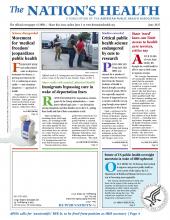
Two of the thousands of fired federal workers leave the HHS building in Washington, D.C., on April 1 with their belongings.
Photo by Roberto Schmidt, courtesy AFP/Getty Images
Once home to 28 divisions that worked to improve and protect public health in every corner of the nation, the U.S. Department of Health and Human Services is on its way to becoming unrecognizable.
The Trump administration’s slash and burn of the agency this spring cut the number of divisions by nearly half, eliminating 10,000 critical research, surveillance and front-line public health jobs along the way. The actions are expected to have long-term consequences for disease prevention, food safety, workplace injuries and beyond, public health experts warn.
And while the administration has touted its actions as a cost-saving measure, the nation will pay in the long term, according to Mary Pittman, DrPH, co-founder of For Our Health, an APHA initiative that is convening public health experts and leaders to speak out against anti-science policies.
“Our costs are going to go up on the health care side providing care to people who got sick from things that could have been avoided,” Pittman told The Nation’s Health. “We’re probably going to see a shift in terms of our life expectancy and premature mortality.”
The 2,400 jobs cut across the Centers for Disease Control and Prevention gutted divisions working on issues such as HIV prevention, tobacco control, disease tracking and environmental health. Meanwhile, the 3,500 job losses seen across the Food and Drug Administration will reduce medical product safety and increase the risk of widespread foodborne illness, Pittman said.

People protest firings outside the headquarters of the Centers for Disease Control and Prevention in Atlanta in April. The Trump administration’s slash and burn actions have thrown HHS into chaos.
Photo by Elijah Nouvelage, courtesy Getty Images
At the National Institutes of Health, the loss of 1,200 positions is “devastating,” she said. Cuts at the premier research agency will wipe out a generation of talent in the long-term and stunt progress on studying diseases such as Alzheimer’s and Parkinson’s.
The losses are in addition to the departures of 10,000 HHS employees who previously opted for retirement or a deferred resignation.
“Overall, the country is going to suffer because we will lose our status as leading in innovation,” Pittman said. “The brain drain is going to be critical for people who either are here on visas and are concerned about their status, or are going to look for opportunities elsewhere where there’s funding available to continue their research.”
The axe to U.S. research hit CDC’s National Institute for Occupational Safety and Health particularly hard. At least two-thirds of workers at the agency were fired, upending studies aimed at preventing job-related injuries, illnesses and death, according to the National Council for Occupational Safety and Health. The research also informs enforcement efforts of the Occupational Safety and Health Administration, which investigates unsafe working environments.
Highly hazardous jobs held by immigrant and low-wage workers, many of whom are people of color, will be much more unsafe, according to Jessica Martinez, MPH, the council’s executive director. Before the cuts, it would have taken OSHA 80 years to inspect every U.S. workplace. Going forward, the onus will be on workers to identify workplace hazards and know their rights, she said.
“Bad employers are going to cut corners even more,” Martinez told The Nation’s Health. “There will be less accountability without NIOSH science and data and it becomes harder for OSHA to issue strong rules and easier for companies to exploit that gap. And ironically, it’s not even good for business. The more injuries and illnesses mean more workers comp claims. That leads to rising insurance premiums and operational disruptions for any employer.”
Clear, culturally appropriate public health messaging is also at risk because of the Trump administration cuts, according to one laid-off 20-year CDC employee who spoke with The Nation’s Health. The worker, who did not want to use her name for fear of reprisal, provided culturally competent communication services to promote health equity. When people at CDC wanted to communicate with farm workers about H5N1 bird flu, for example, they relied on her to help craft messages.
“Farm workers have different literacy levels, so they have different needs to be communicated to and our offices have that expertise,” the former CDC staffer said. “We’re not going to be able to reach all folks if this really goes forward as is cut.”
The Trump administration also eliminated the Division of Environmental Health Science and Practice at CDC’s National Center for Environmental Health. Amanda Reddy, MS, executive director of the National Center for Healthy Housing, said her organization relies on the division’s critical data, rapid response and funding to identify which homes are most likely to expose families to hazards, like lead, and target investments in communities that need the most help in removing them.
“Long term, cuts like these could really result in more children with lead poisoning, more asthma hospitalizations and more lives harmed or even cut short by preventable environmental exposures,” Reddy told The Nation’s Health. “We would love to get serious about making America healthy again, but we’re not going to get there as a nation by cutting the very programs that protect kids from environmental asthma triggers or lead poisoning.”
Smaller HHS agencies were not spared. The Agency for Healthcare Research and Quality saw a complete shuttering of its Patient Safety Network, which turns real-world medical care experiences into evidence-based recommendations for clinicians. Robert Valdez, PhD, MHSA, a former AHRQ director, said the action will make it harder for public health professionals to access critical data.
“These cuts and these closures of programs will slow the pace of medical and public health research and medical progress,” Valdez, another co-founder of For Our Health, told The Nation’s Health. “It’s going to curb access to high-quality care.”
Confusion around the HHS reorganization has left state and local health departments in a tailspin about who they respond to on the federal level, said Susan Kansagra, MD, MBA, chief medical officer for the Association of State and Territorial Health Officials.
“Some might be able to absorb in different ways or look to their own state funding to help support and offset some of the activities,” Kansagra told The Nation’s Health. “But many have said that they will have to lay off staff and terminate contracts.”
Valdez said that Congress needs to have oversight of the restructuring of existing HHS agencies and provide adequate and predictable public health funding for local, state and territorial public health systems.
On April 1, 23 states and the District of Columbia sued the Trump administration after it clawed back $11 billion in funding to state and local health departments. The funds were a continuation of COVID-19 relief money used for services such as immunizations and tracking infectious diseases, including the deadly measles outbreak that began in West Texas.
In the long run, Pittman predicted the Trump administration reorganization of HHS will prove to be ineffective.
“What you’re looking at is a hodgepodge that’s going to cost more money, and it’s not going to meet the needs of the people of the United States,” Pittman said. “It’s hard for me to see the logic model that they’ve used to put that together.”
For more information, visit www.forourhealth.org.
- Copyright The Nation’s Health, American Public Health Association









